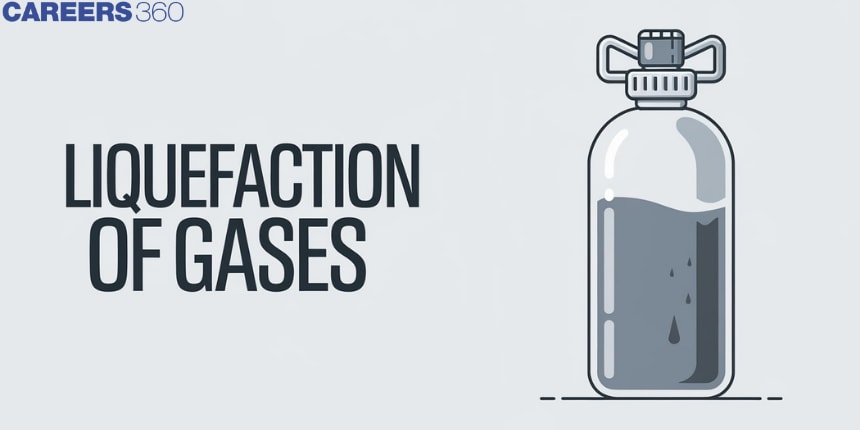Liquefaction of Gases
Liquefaction of gases is a process of transforming gas into its liquid form. Herein, a gas is cooled and/or its pressure is increased to an extent that it condenses into a liquid state. For example, liquefied natural gas, or LNG, is used as fuel for heating and cooking. Liquefied natural gas is used to store and transport natural gas due to its minimal volume use compared to gas. Nitrogen is also applied in food processing, where it can fast-freeze foods to preserve them.
This Story also Contains
- Liquefaction of Gases
- Some Solved Examples
- Summary

Liquefaction of Gases
Liquefaction of gases is done under the following two conditions: (i) Low temperature (i) High pressure

- Low Temperature: As the temperature of the gas is lowered, the kinetic energy of the molecules decreases. The volume occupied by the gas also decreases. At very low-temperature molecules come very close to each other, later on coming more closer they ultimately change into the liquid state.
- High Pressure: Increase in pressure brings the gaseous molecules closer and closer to one another. So, this factor also helps in converting the gas into the liquid.
For each gas there is a certain temperature above which the gas cannot be liquefied however high pressure is applied. Therefore we can say that the effect of temperature is more important than that of the pressure.
Critical Temperature Tc
Critical temperature of a gas may be defined as that temperature above which the gas cannot be liquefied however high the pressure is applied on the gas.
The critical temperature of a real gas is given by $\mathrm{T}_{\mathrm{c}}=\frac{8 \mathrm{a}}{27 \mathrm{Rb}}$
Critical Pressure Pc
The minimum pressure that must be applied on a gas at its critical temperature to just liquefy it.
The critical pressure of a real gas is given by $P_c=\frac{a}{27 b^2}$
Critical Volume Vc
The volume occupied by one mole of a gas at its critical temperature and critical pressure is known as the critical volume.
The critical volume of a real gas is given by $V_c=3 b$
At critical point,$\mathrm{Z}=\frac{\mathrm{P}_{\mathrm{c}} \mathrm{V}_{\mathrm{c}}}{\mathrm{RT}_{\mathrm{c}}}=\frac{3}{8}$
Significance of a and b
- It gives the magnitude of attraction forces present between gas molecules.
Liquefication of gases ∝ a
Hence more the value of 'a' or force of attraction between the molecules of a gas, more will be its liquefaction:
Example$
\begin{aligned}
& \text { Values of 'a' } \\
& \mathrm{He}<\mathrm{H}_2<\mathrm{O}_2<\mathrm{N}_2<\mathrm{CO}_2<\mathrm{HCl}<\mathrm{NH}_3<\mathrm{SO}_2 \\
& \mathrm{a} \rightarrow(0.034)(0.244)(1.36)(1.39)(3.59)(3.8)(4.17)(6.71)
\end{aligned}
$Increasing order of liquefication of some gases
- Its constancy in value shows that gas molecules are incompressible. $\mathrm{b}=4 \mathrm{~N}\left(\frac{4}{3} \pi \mathrm{r}^2\right)$
- At low pressure 'a' dominates but at high pressure 'b' dominates.
Recommended topic video on (Liquefaction of gases)
Some Solved Examples
Example 1: For a real gas the P-V curve was experimentally plotted and it had the following appearance. With respect to liquefaction. Choose the correct statement.

1)at T = 500 K, P = 40 atm, the state will be liquid.
2)at T = 300 K, P = 50 atm, the state will be gas.
3)at T < 300 K, P > 20 atm, the state will be gas.
4) at 300 K < T < 500 K, P > 50 atm, the state will be liquid.
Solution
Liquefaction of gases -
At high pressure, molecules of gas come close to each other. As a result, intermolecular attraction forces increase. When it is allowed to escape through a nozzle into a region of low pressure, the molecules move apart.
In doing so, energy is needed to overcome intermolecular attraction forces. This energy is taken from the molecules themselves. Therefore the gas is cooled.
This process is repeated many times until the gas is completely changed into the liquid state.

(a) at T = 500 K, P = 40 atm corresponds to 'a' substance - gas
(b) at T = 300 K, P = 50 atm corresponds to 'b' substance - liquid
(c) at T < 300 K, P > 20 atm corresponds to 'c' substance - liquid
(d) at T < 500 K, P > 50 atm corresponds to 'd' substance - liquid
Example 2: Critical temperatures of ammonia and carbon dioxide are 405.5 K and 304.10 K, respectively. Which of these gases will liquify first when you start cooling from 500 K to their critical temperature?
1) Ammonia
2)Carbon dioxide
3)Both will liquify at same time
4)Nothing can be predicted
Solution
Since the critical temperature of ammonia is higher than that of carbon dioxide, ammonia will liquify first as its critical temperature will be reached first. The liquefaction of carbon dioxide will require cooling to a lower temperature.
Hence, the answer is the option (1).
Example 3: Critical temperature for carbon dioxide and methane are $31.1^{\circ}$ and $-81.9^{\circ} \mathrm{C}$ respectively. Which of these has stronger intermolecular forces?
1) Carbon dioxide
2)Methane
3)Both have same intermolecular forces
4)Nothing can be predicted
Solution
We have1:
$T_c$ for $\mathrm{CH}_4=-81.9^{\circ} \mathrm{C}$ and $T_c$ for $\mathrm{CO}_2=31.1^{\circ} \mathrm{C}$
Clearly, $\mathrm{CO}_2$ has more vital intermolecular forces of attraction as it has a higher value of critical temperature.
Hence, the answer is the option (1).
Example 4: The critical temperature of $\mathrm{O}_2$ is less than $\mathrm{H}_2 \mathrm{O}$ because the $\mathrm{H}_2 \mathrm{O}$ molecules have:
1)Two covalent bonds
2) Dipole moment
3)Fewer electrons than $\mathrm{O}_2$
4)V-shaped structure
Solution
We know that the dipole moment in a molecule results in strong intermolecular forces and since
$T_c=\frac{8 a}{27 R b}$
Thus, the critical temperature of $\mathrm{H}_2 \mathrm{O}$ is more for $\mathrm{O}_2$ .
Hence, the answer is the option (2).
Summary
Liquefaction of gases is the process whereby gases are converted to liquids either by cooling and/or under increased pressure. This is very important in storage and transportation because it takes less space than the gas. For example, the concepts of gas liquefaction are also applied in air conditioning and refrigeration to cool our surrounding environments for a better life with more comfort.